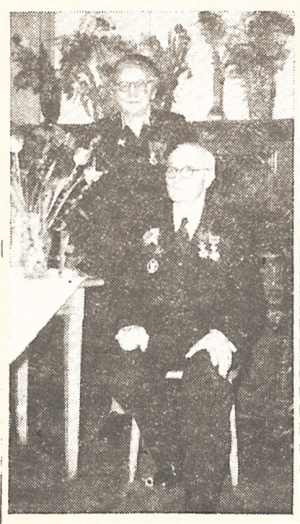If this site was useful to you, we'd be happy for a small donation. Be sure to enter "MLA donation" in the Comments box.
Anderson, Sarah Kroeker (1882-1969)
Mennonite Weekly Review: 1956 Sep 12 p. 11
Birth date: 1882
text of article:
Portrait of a Missionary
(Editor's Note: Interesting glimpses into the life and work of a pioneer missionary to Africa under the Congo Inland mission are given in this "portrait" by Mrs. Henry A. Toews, who with her late husband also served in the Congo for many years.)
SARAH Kroeker was tall and dark haired with well built shoulders. As one looked at her one got the impression that she could "take it" even though she was a woman. Her friendliness was perhaps her most noticeable feature, but it was her generosity that won her way into the hearts of folk. Her influence was felt on three continents — America, her home, Africa, her field of service and Europe, for Sweden was her adopted home.
It was in 1912 that she left the shores of her homeland as a trained nurse to go to London to study tropical diseases. From there she went to the Congo to Work under the newly founded Congo Inland Mission. Her first love was for the children of Congo who touched the hem of her skirt as she walked in the Congo villages. She also hoped to help the mothers of Congo for which work she was particularly trained.
IN CONGO she lived in a mud and stick hut like the Africans did. She was expecting a few things of beauty to adorn her hut after her boxes came from Montgomery Ward, but her boxes were a long time coming, and then some of the very necessary items had disappeared. They had been raided and her shoes were missing.
Shoes are a very important item of apparal [sic] since the ground is infested with parasites. Neither do shoes have a long life in the tropics. Like the shoes of the children of Israel in their wanderings in the wilderness, they seem to have a very short life span due to the warm, sandy soil upon which one walks. It would take over a year before another order could be sent out. . . .
SARAH had not been in the Congo very long, and had not yet mastered the native language, when a caller came to the veranda. He wished to inquire of Mrs. Haigh, the senior missionary, concerning the new-comer.
"Is the lady unmarried?" asked the Chief.
"That's right — she is not married," said Mrs. Haigh, suspecting the purpose of the Chief.
"What would it take to betrothe a woman like that?" asked the Chief.
"Well, you know she is a trained nurse, and can take care of sick folk, so she is very valuable," laughingly answered the senior lady. "It would take many head of cattle — say a dozen or so."
The chief jingled his hippo-tooth necklace and drew his shirred grass skirt around him tighter and then strutted back to the village.
Some time later, that same Chief returned, wearing a vest and a pair of trousers. A retinue of cattle was following together with their caretakers. He had come to press the matter of the unattached lady.
"Here are the cattle and I have changed my appearance to be acceptable to the young lady," said the Chief.
Mrs. Haigh hastily explained the state of affairs to Sarah, who graciously but firmly declined the marriage offer.
BEING a trained nurse, she was expected to take care of missionaries who were ill as well as Africans. Rev. Stevenson, who had come about the time the Haighs had come, was ill with T. B. His wife and children had stayed in Canada, and expected to follow him later after he had established himself. The Haighs also assisted in caring for Rev. Stevenson, but since Sarah was the nurse the responsibility rested on her shoulders.
After some weeks of very severe illness Rev. Stevenson died. That was in 1912 and in order to have a coffin the missionaries made one from Montgomery Ward boxes, and buried the first white person to die on the C. I. M. field.

Mennonite Weekly Review obituary: 1969 Jul 3 p. 3